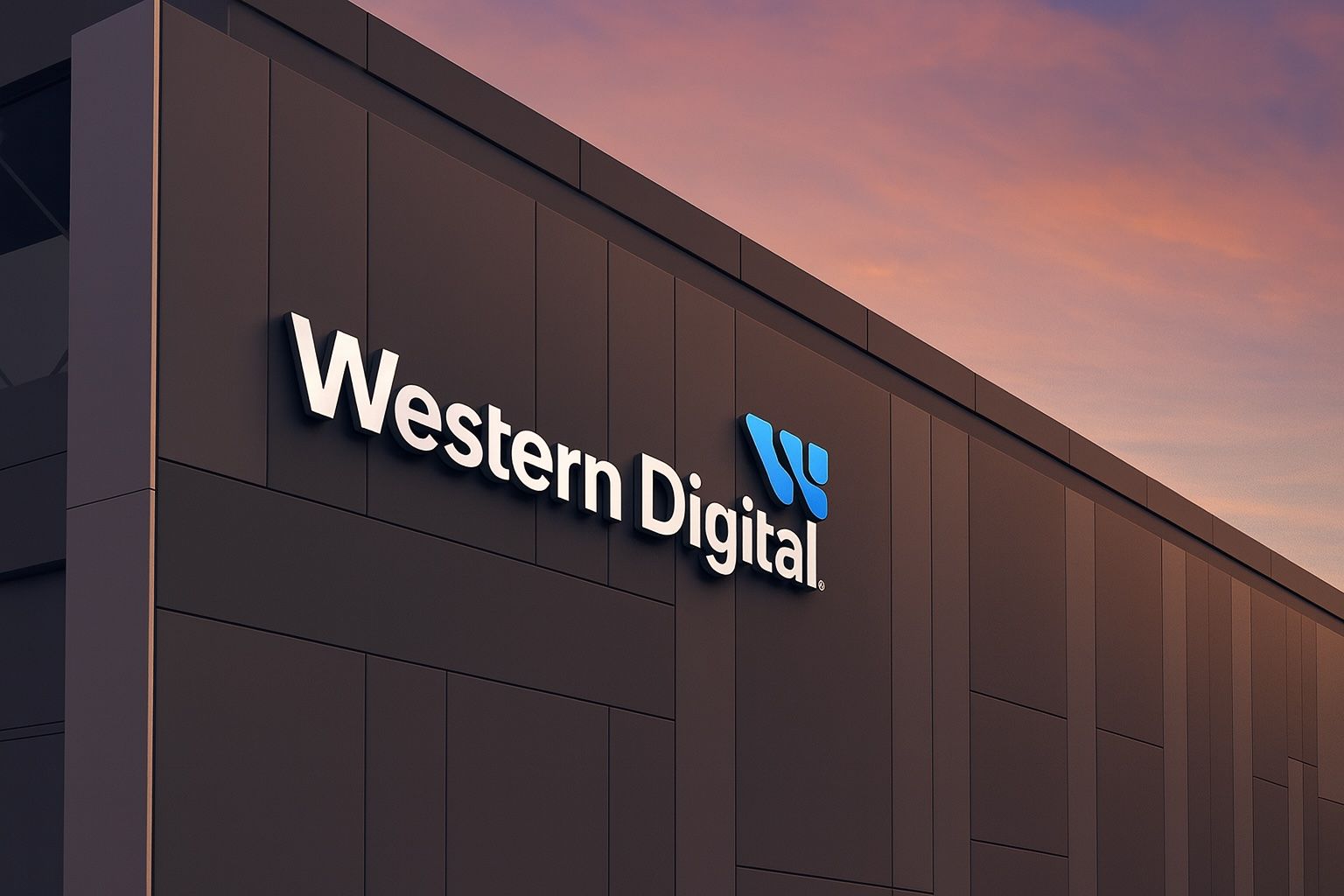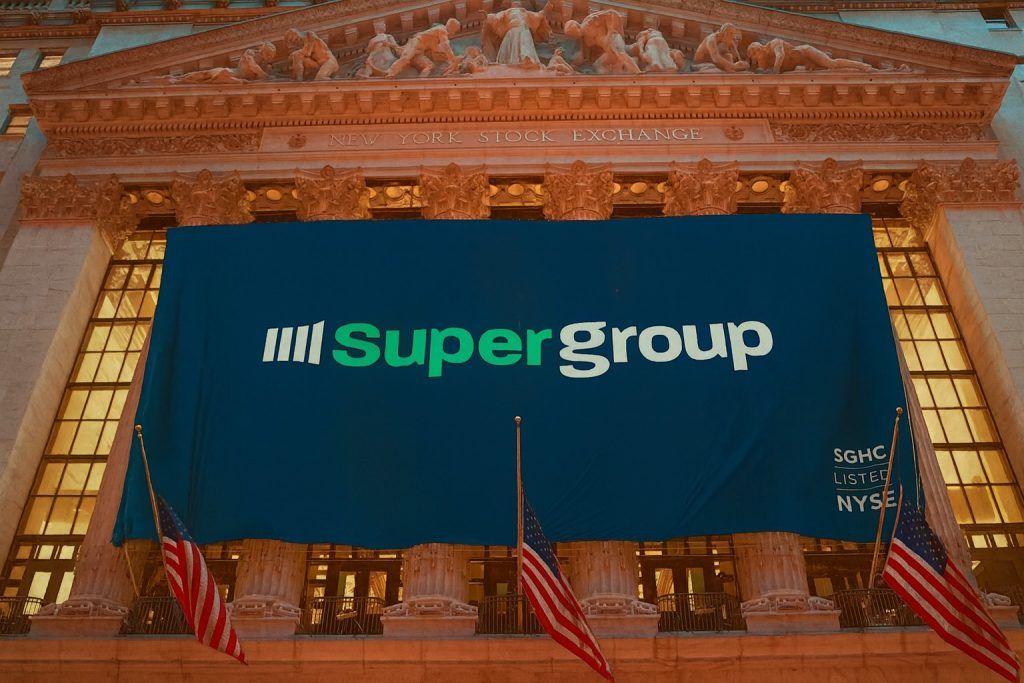- SanDisk Acquisition & Spin-off: Western Digital Corp. acquired SanDisk (former NASDAQ: SNDK) in 2016 for ~$19 billion (final ~$16 billion after adjustments) [1], integrating SanDisk’s flash memory business into WDC. In February 2025, Western Digital spun off the flash division as a separate SanDisk Corporation (re-listed under ticker SNDK), refocusing WDC on its core hard-disk drive (HDD) business [2]. WDC retains an equity stake in the new SanDisk.
- 2025 Stock Surge: Western Digital’s stock price has nearly doubled in 2025, reaching multi-year highs amid booming demand for data storage. WDC and peer Seagate both saw shares soar ~100% year-to-date – making them among 2025’s top S&P 500 performers – fueled by the AI-driven surge in demand for high-capacity drives [3]. WDC even briefly outpaced popular AI plays like Palantir in YTD performance [4].
- Financial Rebound: Western Digital’s financial performance rebounded sharply in 2025. Fiscal 2025 revenue was $9.52 billion, up 51% year-over-year [5], after a severe industry downturn in 2022–2023. The company swung back to profitability, with improving margins and positive free cash flow. In the June 2025 quarter, revenue hit $2.61 billion (up 30% YoY) [6], and WDC resumed shareholder returns – initiating a dividend ($0.10/share) and a $2.0 billion stock buyback program [7] as debt levels were reduced.
- Storage Industry Upswing: The broader NAND flash memory and storage industry entered an upswing in 2025. After a glut in late 2022–2024 that drove prices down, production cuts by manufacturers and surging AI-related demand have tightened supply. Analysts noted the NAND market was “plagued by oversupply” in early 2025 [8], but by mid-2025 demand was outpacing supply, supporting a price rebound [9] [10]. HDD and SSD prices have been rising as data center buyers scramble for capacity in the “unprecedented demand” of the AI era [11].
- Future Outlook: Looking ahead, Western Digital forecasts continued growth into 2026. The company expects Q1 FY2026 revenue to rise ~22% year-on-year [12] [13], driven by cloud and enterprise sales. Management is optimistic that HDDs will remain critical – “the foundation of the world’s data infrastructure” – in an AI-driven future [14]. Wall Street analysts have turned bullish on WDC and peers: Morgan Stanley upgraded WDC as a “top pick”, citing its strong positioning and relative value [15], and other experts see the company benefiting further from AI and cloud spending trends.
Company Overview: SanDisk’s Journey into Western Digital
SanDisk was a pioneering flash memory company (founded 1988) known for its memory cards, USB drives, and SSDs. In October 2015, Western Digital (WDC), a longtime leader in hard disk drives, announced plans to acquire SanDisk for about $19 billion [16]. The deal was completed in May 2016 at a ~$16 billion valuation after adjustments [17]. This acquisition was transformative for Western Digital, instantly adding a full suite of NAND flash technology and products to complement WDC’s HDD lineup. SanDisk’s flash memory expertise allowed Western Digital to offer everything from mobile memory cards to enterprise solid-state drives, alongside its traditional disk drive products.
For nearly a decade, SanDisk operated under Western Digital’s umbrella as its Flash Products division. SanDisk’s branding continued (e.g. SanDisk memory cards), and Western Digital also sold flash-based storage under its own brand. The combination made WDC one of the world’s most diversified data storage companies, with a dual portfolio of HDD and SSD/flash products.
However, by 2022–2023, investor pressure was mounting to unlock the value of WDC’s disparate businesses. Activist shareholders (notably Elliott Management) argued that the sum-of-the-parts valuation of Western Digital’s HDD and flash units would be higher if they were separate [18]. In October 2023, Western Digital’s board agreed to pursue a split: the plan was to spin off the Flash memory business into a standalone public company reviving the SanDisk name [19]. This would leave Western Digital Corp. focused solely on the hard drive business (manufacturing HDDs for PCs, data centers, etc.), while the new SanDisk Corp. would encompass all flash memory operations (including the existing joint venture production with Kioxia, formerly Toshiba Memory).
The separation was completed on February 24, 2025. SanDisk Corporation was re-listed on NASDAQ under the ticker “SNDK”, the same symbol it had before the 2016 acquisition [20]. Western Digital’s then-CEO, David Goeckeler, even left WDC to lead the new SanDisk company, reflecting the significance of the flash unit’s scope [21]. Post spin-off, Western Digital Corp. retained an equity stake in SanDisk [22], but WDC’s day-to-day business is now centered on hard drives and related storage systems. Essentially, Western Digital “unwound” the 2016 merger to some degree – a full-circle moment that acknowledged the different market dynamics of HDD vs. flash.
Today, Western Digital’s business is concentrated on HDD technology (for consumer PCs, enterprise servers, cloud data centers, surveillance systems, etc.), where it remains one of a duopoly (with Seagate) supplying most of the world’s hard drives. The SanDisk flash memory business continues in the separate entity, though Western Digital as a corporation still benefits indirectly via its ownership stake in SanDisk and through ongoing partnerships (e.g. technology sharing from the flash joint-ventures). This strategic realignment is intended to allow each business to pursue its own growth and investment strategy – for example, Western Digital can focus on next-generation HDD R&D, while SanDisk can independently seek opportunities (some observers speculate SanDisk may explore a future combination with Kioxia or other flash makers). Overall, the SanDisk acquisition gave Western Digital vital flash capabilities for the past several years, and even after the spin-off, SanDisk’s legacy lives on through Western Digital’s product portfolio (many WDC-branded SSDs were transitioned to the SanDisk brand) and through WDC’s shareholder value (via its SanDisk stake).
Current Performance (2025)
Stock Performance: 2025 has been a breakout year for Western Digital’s stock (NASDAQ: WDC). After languishing during the 2022–2023 tech slump, WDC shares have rallied dramatically. As of Q4 2025, the stock was up roughly 100% year-to-date, roughly doubling in price [23]. In mid-September 2025, Western Digital stock even hit new multi-year highs, closing in on the $100 per share level, buoyed by excitement around AI-related demand. This surge has made WDC one of the top performers in the S&P 500 for 2025 – at one point, both Western Digital and Seagate had outperformed even high-flying AI software names. For instance, on a single day in September, WDC jumped ~5% to a record high after news it was raising drive prices due to strong demand [24]. Overall investor sentiment toward storage stocks flipped to extremely optimistic in 2025, a stark contrast to the previous year’s pessimism.
Financial Results: Western Digital’s financial results in calendar 2025 reflect a strong rebound from the prior downturn. In the quarter ending June 27, 2025, WDC reported revenue of $2.61 billion, a 30% increase year-over-year [25]. This capped off fiscal year 2025 (FY25) revenue of $9.52 billion, up 51% from FY24’s $6.32 billion [26]. Such growth is striking – it illustrates how dramatically conditions improved versus the severe slump in 2024 (when oversupply and weak demand hit storage makers hard). Gross margins expanded as well (FY25 GAAP gross margin ~38.8%, up from 28.1% a year prior) [27], as higher utilization and firmer pricing kicked in. Western Digital swung from losses in 2024 to solid profits in 2025: for example, Q4 FY25 GAAP EPS was $0.67 (non-GAAP $1.66) [28], and full-year FY25 GAAP net income was over $2.3 billion (versus a loss in FY24).
Notably, Western Digital used its renewed cash flow to strengthen its balance sheet and reward shareholders. In the June 2025 quarter, the company generated $746 million in operating cash flow and $675 million in free cash flow [29]. Management applied $2.6 billion to pay down debt during the quarter [30], significantly deleveraging after the spin-off. In July 2025, Western Digital reinstated a quarterly cash dividend (something it had suspended in recent years), declaring $0.10 per share [31]. It also announced a new $2 billion stock buyback authorization [32]. These moves signal confidence in the company’s stability and long-term cash generation. As CEO Irving Tan noted, WDC’s strong free cash flow and improved outlook prompted the board to authorize returning capital to shareholders [33]. The dividend may be modest, but it positions WDC once again as an income-paying tech stock, similar to rival Seagate which has long paid dividends.
Key 2025 Developments: A major headline in early 2025 was, of course, the completion of the SanDisk spin-off in February. This was closely watched by investors. When separated trading began, WDC’s stock initially dipped only ~3% and SanDisk (SNDK) stock fell ~7% on its first day [34], but importantly the combined value of the two stocks was higher than WDC alone pre-split (a combined ~$22.5B market cap versus ~$17.9B before) [35]. This outcome validated the spin-off, suggesting the market agrees that two focused companies are better. WDC’s subsequent strong earnings and stock run-up further show that the leaner Western Digital (post-spin) is thriving on its own.
Another key development has been record demand from cloud and AI customers. Western Digital’s largest segment now is selling high-capacity drives for enterprise datacenters (“nearline” HDDs). In 2025, orders from hyperscale cloud providers and AI server builders surged. WDC reported that its Cloud end-market revenue grew fastest, and by early 2025 cloud represented over 40% of total revenue [36]. The AI boom led to unusual situations: by September, Western Digital and others reportedly even hiked drive prices due to tight supply – WDC told customers it was raising HDD prices because of “unprecedented demand” in the AI era [37]. Some buyers faced shipping delays up to 10 weeks for certain high-capacity drives, according to industry reports, as suppliers struggled to keep up [38] [39]. This is a stark reversal from 2022, when drives were in oversupply and prices were falling. The swing to shortages underscores how quickly the market flipped as AI infrastructure build-outs accelerated in 2025.
On the flash memory side (SanDisk’s realm), market conditions also improved markedly in 2025 – which indirectly benefits WDC via its stake and earlier inventory adjustments. SanDisk (the new company) has seen its stock nearly triple since the spin-off [40] [41], reflecting optimism that flash memory prices have bottomed out and are rising again. Western Digital’s own financials through Q2 FY25 still included the Flash business, which had been a drag in 2024. But by Q2 FY25 (Oct–Dec 2024), WDC’s flash segment stabilized and was managing through pricing pressure [42]. With flash now separated, WDC’s ongoing results (from Q3 2025 onward) purely reflect the HDD business, which is currently on an upswing.
In summary, Western Digital’s 2025 performance has been characterized by a sharp recovery in sales and profit, a soaring stock price, and strategic moves to reshape the company. After weathering a brutal down-cycle, WDC emerged in 2025 as a more focused company enjoying strong demand. Its execution (e.g. cost cuts in 2023, inventory reductions) positioned it to capitalize when the tide turned. The question for investors is whether this momentum can be sustained into 2026 and beyond – a topic we explore next.
Industry Overview: NAND Flash Memory & Data Storage
Western Digital operates in the broader data storage industry, which spans traditional magnetic hard drives (HDDs), solid-state drives (SSDs), and NAND flash memory chips. This industry is famously cyclical – subject to boom-and-bust based on supply/demand imbalances. The past few years have illustrated this cycle vividly.
Recent Downturn (2022–2024): The storage market went through a severe downturn in late 2022 through 2023. On the flash side, NAND memory makers like Micron, Samsung, Kioxia, and Western Digital’s SanDisk unit faced oversupply as demand from PCs and smartphones slowed just as huge new chip fabs came online. NAND prices plummeted, and revenues for these companies collapsed. SanDisk’s own financials (when it was inside WDC) show the pain: flash revenue fell from $9.75 B in FY2022 to $6.66 B in FY2024, with corresponding net losses and negative cash flow in 2023–24 [43]. Similarly, Micron and Samsung saw sharp drops in memory earnings – Samsung’s semiconductor division, for example, went from record profits in 2022 to its worst loss on record in early 2023.
On the HDD side, 2022–23 was also challenging. Demand for PC and consumer hard drives dropped (people weren’t buying as many PCs or external drives post-pandemic), and even cloud data center spending paused for a few quarters. Both Western Digital and Seagate had to cut production and lay off staff in 2022–23 as inventories ballooned. HDD industry shipments hit a low point in mid-2023, reaching volumes not seen in decades, and pricing was very competitive.
2024–2025 Recovery and AI Boom: Heading into mid-to-late 2024, green shoots appeared. The storage glut started to clear as suppliers slashed output and customers worked down inventories. TrendForce analysts note that entering 2025, NAND flash producers took “decisive production cuts” to curb supply growth [44], after recognizing that annual NAND demand growth had slowed to ~10–15% (from ~30% historically) [45]. These cuts, along with some improvement in smartphone and PC demand, began to stabilize prices. By Q2 2025, NAND flash price declines had slowed and in some categories turned into increases. In fact, industry data by mid-2025 showed a tightening supply-demand balance – a dramatic change from a year prior [46]. Memory prices (DRAM and NAND) started rising again, helped by the new catalyst on the block: Artificial Intelligence.
AI’s rapid expansion in 2023–2025 has had a massive impact on storage demand. Training advanced AI models (and the data these models generate and analyze) requires huge volumes of data storage – from fast NVMe SSDs close to GPUs, to massive-capacity HDD arrays for archival of training data and cloud backups. As Tom’s Hardware quipped, “AI isn’t just consuming the GPU market. It’s eating storage, too.” Data centers oriented toward AI workloads are equipping themselves with higher capacity drives than ever. For example, SSD demand from AI servers (especially high-end NVMe and emerging technologies like HBM-backed storage) has surged. Enterprise SSDs exceeding 30TB each are now sought by some AI-oriented systems [47]. On the HDD side, nearline (enterprise) HDDs – the kind Western Digital and Seagate produce in 10TB, 20TB, now 22TB+ sizes – are seeing unprecedented uptake by cloud giants to feed AI data storage needs.
A vivid illustration: NVIDIA’s latest AI supercomputer design (for their internal use) was revealed to include multiple 4TB SSDs per node [48] to handle the torrent of data. And on the HDD front, both Western Digital and Seagate report that AI data center customers are buying the highest-capacity drives available in bulk. This led to shortages in 2025 – whereas a year prior there was a glut! Western Digital’s price hike letter in Sept 2025 cited “unprecedented demand in the AI era” for HDDs [49]. Seagate similarly noted it has been shipping 30+ TB HAMR-based drives to meet hyperscale AI storage requirements [50].
Beyond AI, broader trends also favor storage growth: Global data creation is doubling every few years, IoT and edge devices are producing more data, and enterprises are retaining data for analytics longer. Cloud services continue to expand, requiring both high-performance flash storage and economical bulk storage. Even consumer devices (like smartphones with multi-lens 8K video, etc.) drive demand for higher flash memory content. These secular trends mean the storage industry has a strong underlying demand trajectory, even if cyclicality can disrupt it short-term.
Industry Challenges: Despite the current upcycle, the storage industry faces ongoing challenges. Cyclicality is the big one – periods of oversupply will likely recur (for instance, if manufacturers ramp output too much in response to this AI boom, another glut could form by 2026–27). The business is also capital-intensive: both chip fabs for NAND and factories for HDDs require heavy investment in R&D and equipment (e.g. developing next-gen HDD recording technologies or new 3D NAND processes). This can strain balance sheets during down cycles. Competition is another factor: in NAND flash, the market is crowded (Samsung, Kioxia, SK Hynix, Micron, Intel (until recently), YMTC from China, and formerly WDC’s SanDisk unit) – price wars can erupt if demand falters. In HDDs, it’s a duopoly (WDC and Seagate, after Toshiba’s small share), which has generally been rational, but the two constantly race to out-innovate each other in capacity and cost.
Another trend to watch is technology substitution. SSDs have been steadily encroaching on HDDs for many uses – for example, most laptops now use SSDs, not spinning disks. However, HDDs still dominate for “cold storage” due to their cost advantage (cents per gigabyte). The question is how long that advantage lasts; if flash were to get cheap enough or if new storage tech (like DNA storage or some future optical storage) emerged, it could disrupt the balance. For now, though, industry experts and WDC’s leadership believe HDDs and SSDs will coexist with distinct roles: HDD providing the cheapest bulk storage for huge data repositories, and SSD providing speed in applications that need it [51].
Outlook: The consensus in late 2025 is optimistic. TrendForce expects a NAND price recovery in second-half 2025 and into 2026 as AI demand and production discipline continue [52]. Gartner and other tech analysts forecast robust growth in data storage demand (both flash and disk) over the next few years, thanks in large part to cloud, AI, 5G, and edge computing. That said, the industry’s history urges caution – companies must manage supply carefully and not overshoot. Geopolitical factors (like U.S.-China trade restrictions on chips) also play a role; for instance, Chinese entrant YMTC could increase NAND supply if it overcomes sanctions, or demand could shift if Chinese cloud companies are cut off from Western suppliers. These uncertainties aside, Western Digital’s addressable markets – NAND flash (via SanDisk) and enterprise HDD – appear to be entering an up-cycle. After a harsh reset, supply and demand are more balanced, and new drivers (AI/ML, big data analytics) are creating structural growth for storage.
In summary, the NAND flash and storage industry in 2025 is in a much healthier place than a year or two ago. Tight supply and buoyant demand (especially from AI and cloud) have lifted prices and producer fortunes. Western Digital, straddling both HDD and (via partnership) flash segments, is benefiting from this rising tide.
Future Outlook for Western Digital (2026 and Beyond)
Western Digital heads into 2026 with significant momentum but also a new shape as a company. Having shed its flash-memory arm, WDC is now a pure-play on hard drives (with a financial stake in flash rather than direct operations). Here are key factors influencing its outlook:
Continued AI & Cloud Demand: The single biggest tailwind is the ongoing AI-driven demand for storage. WDC’s management emphasizes that we are in the early innings of an “AI data cycle” that will drive exponential data growth [53]. Cloud providers and AI researchers will need more and more high-capacity drives to store training datasets, model checkpoints, user data, backups, etc. Western Digital, as one of only two major HDD suppliers, stands to benefit directly from this demand. The company’s guidance reflects this confidence: for the quarter ending Sept 2025 (Q1 FY2026), WDC projected revenue of ~$2.7 billion, which is 22% higher year-over-year [54] [55]. It also forecast a healthy gross margin (~41%) and strong earnings per share for that quarter [56] [57]. Such growth, if sustained, suggests WDC could approach or exceed $10+ billion in annual revenue in the coming years (even post-spin-off). Wall Street analysts likewise expect robust earnings growth in the near term; for example, Zacks Consensus estimates for WDC’s FY2026 EPS have been revised upward multiple times in late 2025, reflecting improving sentiment [58].
HDD Technology Roadmap: Western Digital’s product development will be crucial in maintaining its competitive edge. The company has been investing in next-generation HDD technologies to increase capacity. Its main rival, Seagate, began shipping HAMR (Heat-Assisted Magnetic Recording) drives in 2023–2024 and has demonstrated ~30+ TB drives in 2025 [59]. WDC has pursued a different approach called ePMR (energy-assisted PMR) and MAMR (Microwave-Assisted) for incremental gains. Western Digital has publicly discussed developing 50TB+ HDDs within a couple of years, potentially using some HAMR as well. In 2025, WDC rolled out 22 TB and 26 TB UltraSMR drives (shingled magnetic recording) for data centers, and it plans 30+ TB conventional drives soon. The timely rollout of higher-capacity drives is critical: cloud customers generally buy the largest drives available to minimize their cost/TB and physical space. If WDC can keep pace with or lead Seagate in offering the largest drives (and do so reliably and cost-effectively), it will secure its share of new deployments. Any missteps (delays or quality issues) could cede ground to Seagate. So far, Western Digital seems on track; in fact, the company claims its HAMR roadmap is on schedule and that it will introduce HAMR-based products when the market is ready, leveraging lessons from Seagate’s early forays.
Flash Memory (SanDisk) Outlook: Although Western Digital proper is now focused on HDDs, its fortunes are still indirectly tied to the flash market through its equity stake in SanDisk and joint venture interests. The new SanDisk Corp’s success will reflect back on WDC’s balance sheet (e.g. via the value of that stake). Here, the outlook is positive: SanDisk (SNDK) is expected to grow as NAND pricing recovers. Analysts at Citi and BofA in Sept 2025 raised their price targets for SNDK to $125 (the stock was ~$99 at the time) citing “further-improving industry fundamentals” after Micron’s strong results [60] [61]. They believe SanDisk will see better profit margins thanks to rising flash prices and the company’s own price hikes on products [62]. If those predictions pan out, SanDisk’s earnings and stock price could climb in 2026–2027, benefitting WDC’s investment value. Moreover, a healthier SanDisk could be a more innovative partner for WDC – for example, collaborating on hybrid storage solutions that combine HDD and flash (Western Digital in the past sold hybrid drives and could continue such cross-product initiatives via arm’s-length agreements).
Strategic Flexibility and Focus: Post spin-off, Western Digital now has a singular focus on being the best in the HDD space. This strategic clarity is an outlook positive. It can allocate R&D and capital solely to hard drive innovations and manufacturing efficiency, without the cross-subsidy that existed when flash was under the same roof. CEO Irving Tan (who took over WDC in 2025) has signaled a disciplined approach: invest in core HDD tech, serve the cloud and enterprise segment with priority, and maintain strong cash generation for shareholders [63]. WDC’s initiation of dividends and buybacks suggests it expects consistent free cash flow ahead, which implies confidence that the HDD business can generate solid profits even as it invests in new technology. The company’s reduced debt also gives it more resilience to withstand any future downturn.
We should also note Western Digital’s role in industry consolidation (or lack thereof). With only two big HDD makers left, there has long been speculation if they might merge or if one might exit the business eventually. Such a merger would likely face antitrust hurdles given it would create a monopoly. Instead, the duopoly structure should keep being advantageous – both WDC and Seagate have an interest in rational competition (not flooding the market or engaging in destructive price wars). The spin-off of flash could also make WDC a leaner acquisition target theoretically (some have mused if a larger tech or industrial company might acquire Western Digital for its HDD business). There’s no concrete indication of that, but the simplified structure at least makes any strategic moves easier to evaluate.
Risks & Challenges: Despite the rosy near-term picture, Western Digital faces some risks going forward. One is the potential of oversupply returning – if macroeconomic conditions weaken or if cloud capex cycles down after the current AI build-out, WDC could see a slowdown. The company must avoid overproduction if demand signals soften. Another risk is technological disruption: while unlikely in the very short term, new storage technologies (for instance, breakthrough advances in solid-state storage or something like Microsoft’s experimental glass storage for archives) could eventually threaten HDD’s dominance in bulk storage. Western Digital will need to continually innovate to keep HDDs cost-advantaged. Even within HDDs, manufacturing these increasingly precise high-density disks is non-trivial – maintaining high yields and reliability at 30TB, 40TB scale is a challenge WDC’s engineers have to meet.
Competition from flash memory will also intensify at the margins. As NAND price per bit declines (especially with technologies like QLC NAND and potentially PLC), SSDs encroach further into territories that used to be HDD-only. For example, some enterprise customers might start using SSDs for warm storage that previously used 10K RPM HDDs. Western Digital’s stake in SanDisk gives it some hedge (since if flash wins, SanDisk wins), but WDC’s own revenue now comes 100% from HDD sales. So it must defend that turf by making HDDs ever more cost-effective and integrated (perhaps with caching software, etc., to boost effective performance).
Long-Term Growth Opportunities: On the positive side, Western Digital could explore new growth angles in the longer term. One idea floating around is HDD-adjacent services – e.g., offering storage systems or cloud storage services, not just selling drives. (WDC does sell storage platforms and JBOD/JBOF systems to some extent). With the flash business gone, WDC might deepen its solutions business to move up the value chain for enterprise customers, bundling drives with enclosures, controllers, and software. Additionally, Western Digital’s brands (WD, HGST, SanDisk – though SanDisk brand is now separate) are strong; leveraging the WD brand in the consumer external drive and NAS markets is still an area of stable cash flow. The company could also partner more freely in flash without the conflict of owning a flash unit – for instance, it could source NAND from multiple suppliers (including SanDisk/Kioxia or others) to incorporate into hybrid products or future NVMe HDD tech (if that ever comes).
In terms of 2026 analyst outlook, the sentiment is largely bullish across the board. Many analysts see Western Digital’s earnings entering an upswing cycle. As of October 2025, analyst price targets for WDC stock have been moving up: the consensus target was around the $100–105 range (with some bulls as high as $150+ and lows around $60) [64]. The stock’s steep rise in 2025 means some of that optimism is already priced in, but on forward earnings WDC’s valuation still appears reasonable compared to peers (analysts cite WDC’s relative valuation discount to Seagate [65], implying WDC shares could have further room to run if it closes that gap). Key bank reports in late 2025 – e.g., Morgan Stanley shifting their top pick to WDC from STX [66], and Wedbush adding WDC to its Best Ideas list [67] – show that experts favor Western Digital’s setup for 2026.
In conclusion, Western Digital’s future outlook for 2026 and beyond appears bright, powered by secular demand for storage (especially from AI/cloud) and a refocused corporate structure. The company is executing well (as seen in 2025’s results) and investing in the right technology. Barring an unexpected downturn in tech spending or a collapse in the currently favorable supply discipline among memory makers, WDC is positioned to ride the data growth wave. The combination of its HDD franchise strength and its indirect participation in flash via SanDisk gives it multiple ways to win. Investors will be watching how Western Digital balances returning cash (dividends/buybacks) with the need to fund innovation, but so far management is striking a confident tone about being able to do both. The next milestones to watch: WDC’s upcoming earnings (to see if the growth targets are met or exceeded) and any indications of how 2026 cloud spending is trending. For now, Western Digital enters 2026 as a leaner market leader in a critical tech infrastructure niche, with the winds of the AI revolution at its back.
Competitor Comparison: WDC vs Seagate, Micron, Samsung
To put Western Digital’s performance and valuation in context, it’s useful to compare it with a few peer companies in the data storage and memory industry. Below is a comparison of Western Digital with Seagate Technology, Micron Technology, and Samsung Electronics, highlighting key metrics and outlook differences:
| Company | Market Focus | FY2025 Revenue (YoY) | 2025 YTD Stock Gain | Key Outlook Factors |
|---|---|---|---|---|
| Western Digital (WDC) | Hard disk drives (HDD); spun-off flash unit (SanDisk). Duopoly leader in HDD for PCs & data centers. | $9.52 B (+51% YoY) [68] [69] | ≈ +100% (stock doubled YTD) [70] | Focused on enterprise/cloud HDD demand; benefiting from AI storage boom and raising HDD prices [71]. Post-spin, WDC is financially stronger (debt reduced) and initiating shareholder returns [72]. Expects ~22% YoY growth next quarter [73]. |
| Seagate Technology (STX) | Hard disk drives (HDD) only. Western Digital’s main rival; the other half of HDD duopoly. | $9.1 B (+39% YoY) [74] (FY25 ended July) | ≈ +110% (more than doubled YTD) [75] | Also riding AI-driven demand – shipped new 30TB HAMR drives to hyperscalers [76]. Margins have expanded (FY25 gross margin ~35% from 23% prior year) as sales rebounded [77]. Offers a higher dividend yield than WDC historically. Outlook positive but WDC’s growth forecast (~22%) outpaces Seagate’s mid-teens revenue growth guidance [78] [79]. Morgan Stanley recently shifted preference to WDC over STX due to valuation upside [80]. |
| Micron Technology (MU) | Memory semiconductor maker – DRAM & NAND flash chips. Competes with SanDisk (Kioxia), Samsung, SK Hynix in memory. | $37.4 B (+49% YoY) [81] (FY25 ended Aug) | ≈ +120% (more than doubled YTD) [82] [83] | Huge 2025 rebound thanks to memory price recovery and AI-driven demand for high-bandwidth memory. Achieved record quarterly sales in data center segment [84]. Returned to profitability with FY25 net $8.5B [85]. Investing heavily in HBM (AI memory) and next-gen NAND. Outlook: Micron sees tight supply into 2026 and has guided for ~61% YoY revenue jump in Q1 2026 [86]. Stock sentiment bullish, though memory remains cyclical (Micron had losses in 2023). |
| Samsung Electronics (005930.KS) | Diversified electronics giant; world’s largest NAND & DRAM producer (memory ~1/3 of revenue). Also major HDD customer (but not producer). | ₩128.5 T (~$98 B) (-?% YoY) Total 2024 revenue (memory segment down in early 2025) | ≈ +75% (KRX:005930 in 2025) [87] | As the market leader in memory, Samsung weathered a tough 2023 (chip profits plunged >90% [88]) but is expected to rebound sharply by late 2025. Higher demand for DDR5, NAND (especially for AI servers) and Samsung’s tech lead in advanced nodes (e.g. TLC/QLC NAND, HBM3) position it well for 2026. Its stock has recovered most losses from 2024. Outlook: Samsung is ramping investment in AI-optimized memory and expects memory market improvements in H2 2025 and 2026. (Samsung’s revenue is not directly comparable, as it includes smartphones, TVs, etc., beyond storage.) |
Key Differences: Western Digital and Seagate are direct competitors, both focusing on HDDs. WDC’s unique aspect was its vertical integration into flash (via SanDisk), but after the spin-off, both WDC and STX are pure HDD plays – although WDC still has a strategic stake in flash. Seagate has traditionally had a slightly higher operating margin and paid a heftier dividend, but WDC is now closing the gap in performance and has resumed dividends [89]. In 2025, WDC actually outpaced Seagate in revenue growth (51% vs 39%), partly because WDC’s flash/HDD mix had been hit harder in the downturn, so its rebound was larger. WDC’s forward growth guidance is also higher than Seagate’s, suggesting it may gain some market share or see stronger orders from cloud customers [90] [91].
Micron and Samsung, on the other hand, are upstream suppliers of memory chips, not drive assemblers. Micron’s fortunes mirror the memory pricing cycle: it had a spectacular FY2025 as memory demand tightened and prices rose, leading to record revenues [92]. Micron’s stock, like WDC’s, has been an “AI beneficiary” in 2025. However, Micron is a much larger company by revenue, and its valuation is tied to expectations for continued memory shortages (e.g. success in AI-centric products like HBM). Samsung dwarfs all these companies in size; it’s a conglomerate, so only its semiconductor division is truly analogous. Samsung’s memory market share (around 33% in NAND, 40%+ in DRAM [93]) means it effectively sets the tone – when Samsung cut memory production in early 2023, it was a key turning point for the industry. Samsung’s outlook as of late 2025 is that its chip profits will recover as AI drives new orders (it’s the primary supplier of advanced HBM memory to NVIDIA, for example). For WDC, Samsung is more partner than competitor in HDD (since Samsung doesn’t make HDDs anymore, having exited years ago), but Samsung competes with WDC/SanDisk in flash memory and could indirectly pressure SanDisk’s results.
Valuation: In terms of valuation metrics, Western Digital and Seagate have historically traded at low price-to-earnings multiples due to volatility. Now with earnings rebounding, both have mid-single-digit forward P/E ratios (ex-spin one-time gains). WDC’s enterprise value-to-revenue is around 2x (post-spin), still a discount relative to some peers. Morgan Stanley noted WDC’s “relative valuation” was attractive vs Seagate [94] – likely referencing that WDC was trading cheaper on a sum-of-parts basis. Micron’s valuation is often measured on price-to-book or forward P/E; it is currently priced for a strong upcycle (forward P/E elevated because current earnings are just recovering). Samsung, being diversified, trades around 10-15x earnings, but that doesn’t directly map to its memory business profitability.
Competitive Outlook: All players are expected to do well if the AI/cloud boom persists. Western Digital and Seagate will essentially split the growing nearline HDD market. Both are pursuing multi-decade-high capacities (50TB drives by ~2026-27) and are likely to enjoy a benign competitive environment (just each other). Micron and Samsung will battle in the memory arena; their success actually helps WDC’s SanDisk spin-off too, since a rising NAND tide lifts all boats. One wild card is Chinese competition – e.g., Yangtze Memory (YMTC) in NAND and new Chinese HDD initiatives (there are rumors of China trying to create its own HDD maker to reduce import reliance). As of 2025, YMTC has struggled under U.S. sanctions and hasn’t dramatically changed the market, but it’s something to watch.
In summary, Western Digital stacks up well against its competitors after a transformational year. It now has a clearer identity (pure HDD) and is executing strongly, putting it on par with Seagate’s performance while retaining upside via its SanDisk link in flash (somewhat analogous to Micron’s space). The entire storage sector has been uplifted by similar forces in 2025, and Western Digital’s challenge will be to distinguish itself in 2026 by continuing to innovate and perhaps delivering more shareholder value (its new dividend is smaller than Seagate’s ~4% yield, so there’s room to grow if cash flows permit). Investors comparing these names will notice WDC offers a blend of turnaround story and AI exposure, Micron offers a pure AI memory play, Seagate a more income-oriented HDD play, and Samsung a broad tech bellwether with a big memory arm. Diversification versus focus is a key differentiator: WDC is now focused, which could mean higher execution risk but also greater reward if it continues to ride the wave it caught in 2025.
Expert Quotes and Analyst Opinions
Industry analysts and financial experts have been actively commenting on Western Digital’s prospects given the recent developments. Here are a few notable quotes and opinions:
- Morgan Stanley (Sept 2025): “Elevating WDC to Top Pick… [after] constructive management meetings,” Morgan Stanley analysts wrote, shifting their preference from Seagate to Western Digital [95]. They cited WDC’s valuation upside and improving fundamentals, noting that AI-driven demand is benefitting all storage makers, but WDC looked particularly attractive. In their view, broader trends are “broadly favoring hard disk makers” with demand outpacing limited supply, enabling both Western Digital and Seagate to enjoy further gains [96]. This bullish stance from a major bank underscores confidence that WDC’s restructuring and market position will translate into stock performance. (Notably, around the same time, Wedbush added Western Digital to its “Best Ideas” list [97], echoing optimism about WDC’s trajectory.)
- Citi on SanDisk/WDC (Sept 2025): After Micron’s blowout earnings in late September, Citi Research highlighted Western Digital’s flash spin-off, SanDisk, as a prime beneficiary of the same trends. Citi analysts raised their Sandisk (SNDK) price target by over 50% (from $80 to $125), citing “further-improving industry fundamentals” post-Micron’s results [98]. They explicitly mentioned that AI tailwinds boosting Micron would similarly help SanDisk’s flash business. This implies a positive read-through for Western Digital as well, since WDC retains a stake and also benefits if the flash market tightens. The Citi team also noted SanDisk (and by extension WDC’s former flash division) should see better margins thanks to higher NAND prices after recent price hikes [99].
- Bank of America (Sept 2025): BofA Global Research doubled down on the bullish flash outlook too – literally doubling its SanDisk target from $59 to $125 [100]. BofA’s analysts wrote “AI demand [is] driving surge in pricing amid tighter NAND market,” and they upgraded SanDisk to a “Buy” [101]. For Western Digital investors, this is a supportive data point: it suggests that the flash memory side (which had been a drag in recent years) is now viewed far more favorably by experts. A rising SanDisk valuation could enhance WDC’s sum-of-parts value. BofA’s call also generally reflects improved sentiment on data storage equities – they see the supply-demand dynamics in NAND improving significantly into 2026.
- MarketBeat Consensus (Oct 2025): According to MarketBeat, Western Digital now carries a “Moderate Buy” consensus rating among Wall Street analysts [102]. Out of dozens of analysts, a majority rate it as a Buy or Outperform, citing the company’s turnaround and leverage to cloud/AI. Price targets range widely (some caution remains, with a few targets in the $60s), but the median target in the $90s implies room for upside from current levels [103]. One high target even reaches $171 [104], reflecting extremely bullish expectations in certain quarters. This spread indicates that while most analysts are positive, there’s still some debate on how sustained the boom will be – a normal situation for a cyclical stock emerging from a trough.
- The Motley Fool (Oct 2025): A Motley Fool analysis pointed out that “Fiscal 2025 has proved exceptionally strong for Micron…[and] Western Digital”, noting WDC’s revenue surge ~51% YoY and Micron’s nearly 50% YoY – both evidence of an “AI-fueled turnaround” in storage [105]. The piece argued that WDC’s spin-off of SanDisk improved its operational focus and that “Western Digital benefits from AI-driven storage demand, strong pricing power, and operational efficiencies after spinning off its flash business” [106]. However, it also cautioned that the stock’s sharp rise means investors should ensure these earnings gains are sustainable and not just a short-term spike from restocking and hype. The Fool’s takeaway was that WDC is positioned well, but shareholders should keep an eye on signs of oversupply returning or AI demand leveling off in late 2026.
- Finance Yahoo (Sept 2025): In an article titled “Should You Jump Into Western Digital After Its 30% Surge on AI Hype?”, an investment columnist noted the rally is driven by real improvements – WDC’s fundamentals (earnings, margins) have improved along with the AI optimism [107]. They highlighted that Western Digital “hiked prices across all of its hard disk drive products in response to the AI boom” [108], which is a rare sign of pricing power in an industry that usually sees cost-down trends. The piece concluded that while WDC’s valuation had rerated higher, if one believes in the multi-year AI infrastructure cycle, Western Digital still appears to have upside. It tempered that with the reminder that WDC is cyclical and historically volatile, so new investors might consider adding on pullbacks.
Overall, the expert sentiment on Western Digital as of late 2025 is largely positive. The company is frequently mentioned as an “AI winner” in the tech stock space, alongside other data infrastructure plays. The successful spin-off and rapid financial recovery have bolstered credibility with analysts. There is a clear narrative from these quotes: Western Digital is riding a favorable wave (AI and cloud demand), and management’s strategic moves are paying off. The key watchpoints analysts mention involve sustainability – i.e., ensuring that this surge isn’t a one-time bump. But with multiple firms raising targets and recommending the stock, the consensus is that Western Digital’s transformation plus industry tailwinds make it an attractive investment case going into 2026.
Sources and Further Reading
- Western Digital Investor Reports: Western Digital Corp. FY2025 financial results (press release) – Western Digital Newsroom, July 30, 2025 [109] [110]. (Provides official revenue, margin, and strategy updates from WDC management.)
- Western Digital Completes Flash Spin-off: “Western Digital Completes Planned Company Separation” – Western Digital Press Release, Feb 24, 2025 [111] [112]. (Details on the SanDisk spin-off and post-split company structure.)
- Investopedia – AI Storage Boom: Kara Greenberg, “Some of the Biggest AI Winners of 2025 Are Data Storage Stocks,” Investopedia, Sept 15, 2025 [113] [114]. (News analysis of WDC, Seagate, Pure Storage surging on AI demand; includes Morgan Stanley and Wedbush analyst commentary.)
- Investopedia – SanDisk Outlook: Janet H. Cho, “Why Sandisk Bulls Are Becoming Even More Bullish After Micron’s Results,” Investopedia, Sept 24, 2025 [115] [116]. (Discusses analysts raising SanDisk (and implicitly WDC flash business) targets post-Micron earnings; quotes from Citi and BofA.)
- TrendForce Memory Market Update: “Supplier Production Cuts and AI Demand Expected to Drive NAND Flash Price Recovery in 2H25,” TrendForce press release, Feb 17, 2025 [117] [118]. (Industry research on NAND oversupply easing, production cuts, and forecast of price rebound due to AI and smartphone demand.)
- Blocks & Files – WDC/SanDisk Split: Chris Mellor, “Western Digital, Sandisk begin separate trading after split,” Blocks & Files, Feb 25, 2025 [119] [120]. (Reports first-day trading of WDC and SNDK post-spin; breakdown of market cap increase and Elliott Management’s role.)
- MarketBeat – Analyst Ratings: Western Digital (NASDAQ: WDC) Analyst Ratings and Price Targets, MarketBeat, Oct 4, 2025 [121]. (Aggregates Wall Street analyst ratings and target prices for WDC; indicates overall Moderate Buy consensus.)
Western Digital’s journey from absorbing SanDisk to spinning it back out, and its resurgence in the stock market, has been well-covered by these sources. Interested readers can refer to them for deeper financial details and the latest analyst perspectives. The storage industry’s evolution remains dynamic, and Western Digital’s performance in the coming quarters will be closely watched against the backdrop of these expectations and trends.
References
1. en.wikipedia.org, 2. en.wikipedia.org, 3. www.investopedia.com, 4. www.investopedia.com, 5. www.westerndigital.com, 6. www.westerndigital.com, 7. www.westerndigital.com, 8. www.trendforce.com, 9. www.trendforce.com, 10. www.trendforce.com, 11. www.investopedia.com, 12. www.westerndigital.com, 13. www.westerndigital.com, 14. www.westerndigital.com, 15. www.investopedia.com, 16. en.wikipedia.org, 17. en.wikipedia.org, 18. blocksandfiles.com, 19. en.wikipedia.org, 20. en.wikipedia.org, 21. en.wikipedia.org, 22. en.wikipedia.org, 23. www.investopedia.com, 24. www.investopedia.com, 25. www.westerndigital.com, 26. www.westerndigital.com, 27. www.westerndigital.com, 28. www.westerndigital.com, 29. www.westerndigital.com, 30. www.westerndigital.com, 31. www.westerndigital.com, 32. www.westerndigital.com, 33. www.westerndigital.com, 34. blocksandfiles.com, 35. blocksandfiles.com, 36. www.westerndigital.com, 37. www.investopedia.com, 38. www.investopedia.com, 39. www.investopedia.com, 40. www.investopedia.com, 41. www.investopedia.com, 42. www.westerndigital.com, 43. blocksandfiles.com, 44. www.trendforce.com, 45. www.trendforce.com, 46. www.trendforce.com, 47. www.trendforce.com, 48. www.trendforce.com, 49. www.investopedia.com, 50. www.investopedia.com, 51. www.westerndigital.com, 52. www.trendforce.com, 53. www.westerndigital.com, 54. www.westerndigital.com, 55. www.westerndigital.com, 56. www.westerndigital.com, 57. www.westerndigital.com, 58. www.nasdaq.com, 59. www.investopedia.com, 60. www.investopedia.com, 61. www.investopedia.com, 62. www.investopedia.com, 63. www.westerndigital.com, 64. www.tipranks.com, 65. www.investopedia.com, 66. www.investopedia.com, 67. www.investopedia.com, 68. www.westerndigital.com, 69. www.westerndigital.com, 70. www.investopedia.com, 71. www.investopedia.com, 72. www.westerndigital.com, 73. www.westerndigital.com, 74. www.barchart.com, 75. www.investopedia.com, 76. www.investopedia.com, 77. www.barchart.com, 78. www.barchart.com, 79. sherwood.news, 80. www.investopedia.com, 81. investors.micron.com, 82. www.trefis.com, 83. www.trefis.com, 84. www.investopedia.com, 85. investors.micron.com, 86. www.forbes.com, 87. companiesmarketcap.com, 88. www.bloomberg.com, 89. www.westerndigital.com, 90. www.westerndigital.com, 91. www.barchart.com, 92. investors.micron.com, 93. sqmagazine.co.uk, 94. www.investopedia.com, 95. www.investopedia.com, 96. www.investopedia.com, 97. www.investopedia.com, 98. www.investopedia.com, 99. www.investopedia.com, 100. www.investopedia.com, 101. www.investopedia.com, 102. www.marketbeat.com, 103. tickernerd.com, 104. www.tipranks.com, 105. www.fool.com, 106. seekingalpha.com, 107. finance.yahoo.com, 108. finance.yahoo.com, 109. www.westerndigital.com, 110. www.westerndigital.com, 111. www.westerndigital.com, 112. en.wikipedia.org, 113. www.investopedia.com, 114. www.investopedia.com, 115. www.investopedia.com, 116. www.investopedia.com, 117. www.trendforce.com, 118. www.trendforce.com, 119. blocksandfiles.com, 120. blocksandfiles.com, 121. www.marketbeat.com










